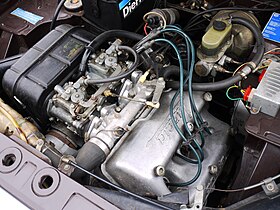Lancia V4 engine
| Lancia V4 engine | |
|---|---|

In Lancia's Fulvia model, the 1.3 litre V4 engine was mounted at a 45° angle.
|
|
| Overview | |
| Manufacturer | Lancia |
| Production | 1922-1976 |
| Combustion chamber | |
| Configuration | |
| Displacement |
|
| Cylinder bore |
|
| Piston stroke |
|
| Cylinder head alloy | Aluminum |
| Valvetrain | |
| Compression ratio | 9.0:1 |
| Combustion | |
| Fuel system | Carburetor |
| Fuel type | Gasoline |
| Oil system | Wet sump |
| Cooling system | Water-cooled |
| Chronology | |
| Successor | Lancia Flat-4 engine |
Italian automobile company Lancia were the first to manufacture cars with V4 and V6 engines in series-production. This started with a number of V4-engine families, that were produced from the 1920s through 1970s.
The Lancia V4 pioneered the narrow-angle V engine design, more recently seen in Volkswagen's VR5 and VR6 engines. By using very shallow V-angles — between 10° and 20° — both rows of cylinders could be housed in an engine block with a single cylinder head, like a straight engine.
A determining characteristic was the use of overhead camshafts (either single or double), in which a camshaft would serve the same function for all cylinders — in both cylinder banks.
The first V4 was used in the Lambda from 1922 through 1931. It was a narrow-angle aluminum design. All three engine displacements shared the same long 120 mm (4.7 in) stroke, and all were SOHC designs with a single camshaft serving both banks of cylinders.
Engines:
The Lambda engine was updated for the Artena. Bore was set at 82.55 mm (3.3 in) as in the 2.6 L Lambda, but stroke was reduced to a more conventional 90 mm (3.5 in). Total displacement was 1,927 cc, with 55 hp (41 kW) produced at 4,000 rpm.
An all-new V4 was designed for the Augusta. Produced from 1934 through 1938, the Augusta's engine displaced just 1,196 cc with a 69.85 mm (2.8 in) bore and 78 mm (3.1 in) stroke. Power output was 35 hp (26 kW) at 4,000 rpm.
The engine was redesigned again for 1936's Aprilia. The first-series cars used a 1,352 cc version with a 72 mm (2.8 in) bore and 82 mm (3.2 in) stroke. Output was 47 hp (35 kW) at 4,300 rpm.
A second series was unveiled for 1939 with an enlarged 1,486 cc engine. It did not share its predecessor's dimensions, with bore now at 74.61 mm (2.9 in) and stroke at 85 mm (3.3 in). Power output was nearly the same at 48 hp (36 kW).
A small V4 (tipo 100) powered the compact 1939 Ardea. It was a 20° narrow-angle engine displacing just 903 cc. Bore and stroke were new again at 65 mm (2.6 in) by 68 mm, and output was just 28.8 hp (21.5 kW). For the 1949 tipo 100B power was increased to 30 hp (22 kW).
...
Wikipedia
